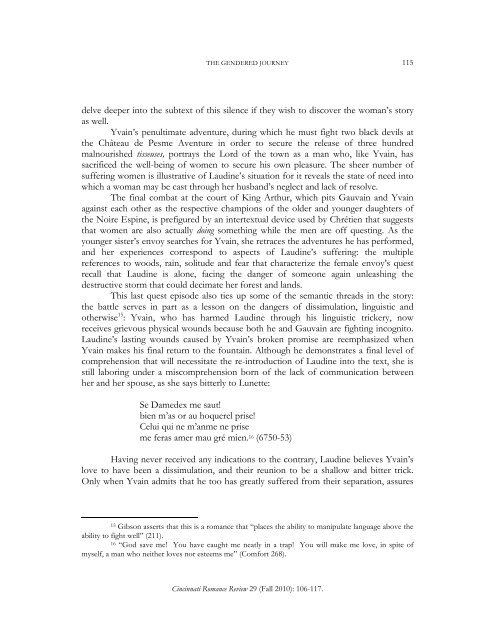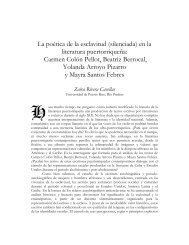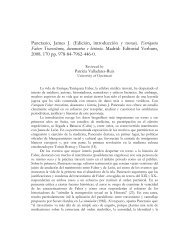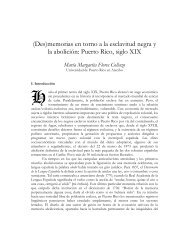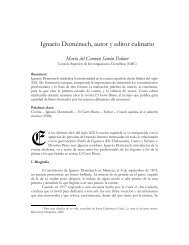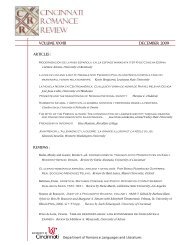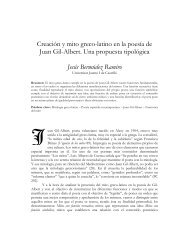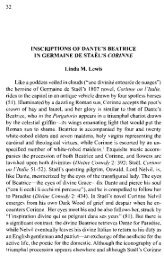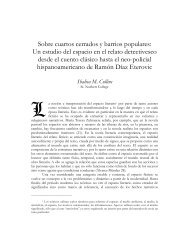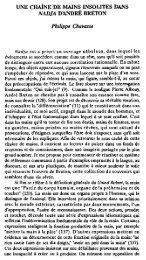Volume 29 - Cincinnati Romance Review
Volume 29 - Cincinnati Romance Review
Volume 29 - Cincinnati Romance Review
Create successful ePaper yourself
Turn your PDF publications into a flip-book with our unique Google optimized e-Paper software.
THE GENDERED JOURNEY<br />
115<br />
delve deeper into the subtext of this silence if they wish to discover the woman’s story<br />
as well.<br />
Yvain’s penultimate adventure, during which he must fight two black devils at<br />
the Château de Pesme Aventure in order to secure the release of three hundred<br />
malnourished tisseuses, portrays the Lord of the town as a man who, like Yvain, has<br />
sacrificed the well-being of women to secure his own pleasure. The sheer number of<br />
suffering women is illustrative of Laudine’s situation for it reveals the state of need into<br />
which a woman may be cast through her husband’s neglect and lack of resolve.<br />
The final combat at the court of King Arthur, which pits Gauvain and Yvain<br />
against each other as the respective champions of the older and younger daughters of<br />
the Noire Espine, is prefigured by an intertextual device used by Chrétien that suggests<br />
that women are also actually doing something while the men are off questing. As the<br />
younger sister’s envoy searches for Yvain, she retraces the adventures he has performed,<br />
and her experiences correspond to aspects of Laudine’s suffering: the multiple<br />
references to woods, rain, solitude and fear that characterize the female envoy’s quest<br />
recall that Laudine is alone, facing the danger of someone again unleashing the<br />
destructive storm that could decimate her forest and lands.<br />
This last quest episode also ties up some of the semantic threads in the story:<br />
the battle serves in part as a lesson on the dangers of dissimulation, linguistic and<br />
otherwise 15 : Yvain, who has harmed Laudine through his linguistic trickery, now<br />
receives grievous physical wounds because both he and Gauvain are fighting incognito.<br />
Laudine’s lasting wounds caused by Yvain’s broken promise are reemphasized when<br />
Yvain makes his final return to the fountain. Although he demonstrates a final level of<br />
comprehension that will necessitate the re-introduction of Laudine into the text, she is<br />
still laboring under a miscomprehension born of the lack of communication between<br />
her and her spouse, as she says bitterly to Lunette:<br />
Se Damedex me saut!<br />
bien m’as or au hoquerel prise!<br />
Celui qui ne m’anme ne prise<br />
me feras amer mau gré mien. 16 (6750-53)<br />
Having never received any indications to the contrary, Laudine believes Yvain’s<br />
love to have been a dissimulation, and their reunion to be a shallow and bitter trick.<br />
Only when Yvain admits that he too has greatly suffered from their separation, assures<br />
15 Gibson asserts that this is a romance that “places the ability to manipulate language above the<br />
ability to fight well” (211).<br />
16 “God save me! You have caught me neatly in a trap! You will make me love, in spite of<br />
myself, a man who neither loves nor esteems me” (Comfort 268).<br />
<strong>Cincinnati</strong> <strong>Romance</strong> <strong>Review</strong> <strong>29</strong> (Fall 2010): 106-117.


